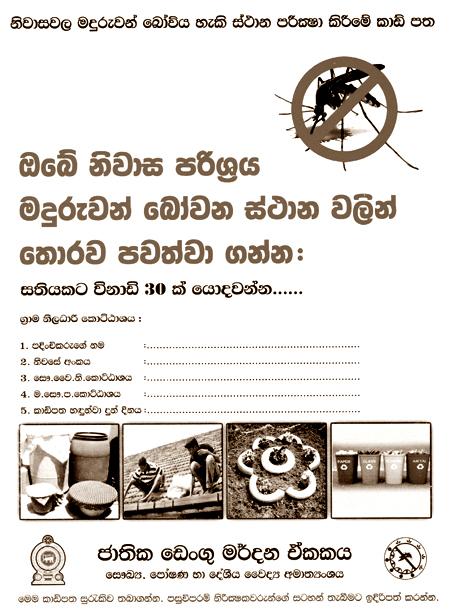
In a bid to eradicate the vectors transmitting Dengue virus the National Dengue Control Unit (NDCU) introduces a new Householder Card to monitor and control the vector breeding places in and around the households. The Card will first be introduced to householders of identified high-risk Grama Niladhari (GN) divisions, said Dr. Hasitha A. Tissera, Head of the NDCU. Along with space for recording actions taken by the householder /family the Card also provides information on mosquito breeding places and how they could be eliminated. The Card is to be used for a period of one year (52 weeks) and would be a convenient monitoring tool in the effort of dengue control in the country.
700 inspection units, consisting a member each from the tri-forces, Police or Civil Defence Force and Public Health Office were deployed in identified areas of the Western, Eastern and Northern Provinces for 3 days (January 17 to 19) last week. While there is a comparative decrease in the spread of the disease in the first two weeks of 2018, “we cannot be complacent about it,” Tissera declared. January 17, recorded 2,982 identified dengue cases throughout the country, about a 45% decline from last year. 10,927 were listed as dengue patients from January 1 -31, 2017.
Six districts (Colombo, Gampaha, Kalutara, Jaffna, Batticaloa and Kalmunai) have been identified as high-risk districts within the three Provinces mainly due to high population density which increases the chance of vector propagation, and thereby spread of the disease.
Householders also have a responsibility in the control of the disease as well as the relevant government stakeholders, Tissera affirmed. “Most of the instances of dengue infections are due to mosquito bites at home, school or at the workplace.”
Follow-up activities by Public Health Officers had revealed mosquito breeding places in and around the households, neighbourhood, workplaces or schools. Aedis aegypti, is the primary vector transmitting the disease in Sri Lanka. The mosquito, just three mili meters (3mm) in size breeds mostly in small clear water containers. It is usually found within 100 metres from human habitats with the adult mosquito’s flight range limited to 200 metres.
Meanwhile, the Colombo Municipality Council (CMC) introduced four mosquito traps, a novelty in the dengue prevention and control effort. The traps, stationed at central sites help in accurately determining the mosquito density of an area, said Dr. Ruwan Wijayamuni Chief Medical Officer of Health of the CMC.
The four traps are designed to attract female mosquitoes through controlled release of carbon dioxide (CO2), ultra violet and infra red lighting and heat generating. The traps provide a 24 hour catch, collected daily by the officers from the entomology unit. They are stationed at Mattakkuliya, Grandpass, Dematagoda and Kirulapone, four key areas identified as high-risk for the spread of dengue. Modera and Mahawatte in Colombo North and Wellawatte in Colombo South are other areas identified as high-risk. All these areas are of high population density. The CMC continues its dengue eradication activities with regular house inspections, indoor fogging and case-based fogging among other methods.
The actions of the newly established Rapid Dengue Response Team (RDRT) have been a success, Wijayamuni stated. Wherever a cluster of dengue patients are recorded the RDRT visits the households, inspecting and eradicating mosquitoes from a minimum of 25 households around the house of the patient. “We take legal action if mosquito larvae is found,” said Wijayamuni. Scattered rains in the past few weeks had contributed to the continuous breeding of the vector, explained Wijayamuni. The CMC also participated in the National Dengue Control Unit (NDCU) lead mosquito inspection program last week.
